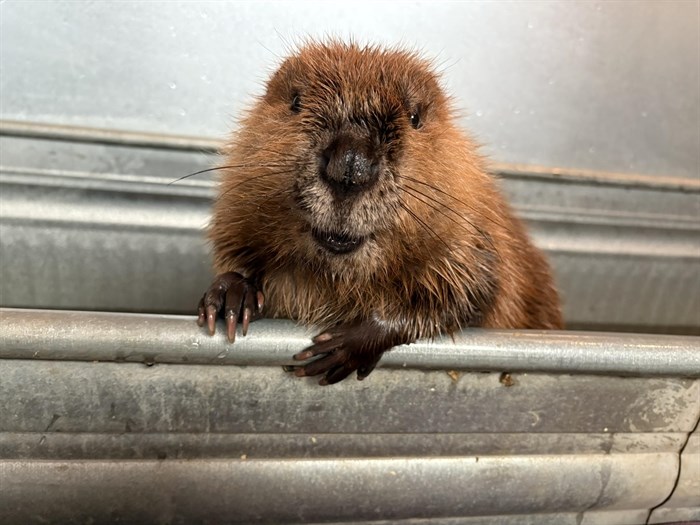
This orphaned beaver is in the care of the Interior Wildlife Rehabilitation Society in Summerland.
Image Credit: SUBMITTED/ Interior Wildlife Rehabilitation Society
April 28, 2025 - 6:00 AM
Anyone with busy beavers on their property knows their natural activities can be a hassle, as the critters can plug up culverts and build dams that cause flooding and elevated water flow.
Some property owners respond by setting kill traps to remove beaver colonies, but Kelowna resident Eva Hartmann is working to change that, as she completes her studies with the Beaver Institute, an organization in the United States.
“Through my program I’m becoming more knowledgeable in helping property owners resolve beaver conflicts without resorting to kill-traps,” Hartmann told iNFOnews.ca said. “The problem is always increasing as our urban spaces expand.”
Hartmann is the executive director of the Interior Wildlife Rehabilitation Society in Summerland and has years of experience working with wildlife, including orphaned beavers, but said this project is separate from the society, and she can’t complete the program without the public’s help.
She is looking for a property owner in the Okanagan who needs help dealing with beavers that have dammed a creek or blocked a culvert on their property, posing a flooding risk for roads or nearby buildings.
“Beavers live in smaller streams or rivers where there are culverts installed under the roads for the stream to flow through and if the beaver plugs the culvert it causes flooding,” she said. “The roads flood frequently if the culverts are unprotected, which can be mitigated by putting the correct kind of fencing on it.
“If a beaver builds a dam on a pond, it can increase the water level of the pond to where it can flood properties and houses on shore, and if that happens, a pond leveller can be installed through the dam.”
While sharing costs with the property owner, Hartmann will install pond levellers or culvert exclusion fences under the supervision of the Beaver Institute. The costs will be far less than ongoing lethal control.
"People don’t have to remove the dam and kill-trap a beaver colony, that’s short term reaction to the problem,” Hartmann said. “If one colony is kill-trapped and the habitat is still good for beavers another colony will move in and build a new dam.”
READ MORE: South Okanagan developer loses appeal of $200K fine for leaky sewage
When asked if killing beavers is legal, Hartmann said it’s difficult to say generally if its legal or illegal to kill a certain kind of wildlife. It all depends on the circumstances and what species it is, who has the permit and what the reason is for wanting to remove the animal. It’s legal if the person doing it has the license to do so and depends on the time of year, what the beaver is doing and why people want to remove it.
Through her role with the Interior Wildlife Rehabilitation Society, Hartmann and her team have rehabilitated and relocated beavers to suitable habits along with help from local conservation groups and First Nations, projects that are lengthy and complicated.
She is working to prevent beavers from being killed, injured or orphaned in the first place. Beavers do important work in the environment by slowing and spreading the flow of water with their dams, making water tables higher.
“Deeper water is colder and beneficial for fish,” Hartmann said. “With rising temperatures in some places fish can’t live or reproduce anymore because water is too hot and shallow. Beavers mitigate drought and improve biodiversity and wildfire resilience in forests.”
The Fur-Bearers are funding Hartmann’s program, and issued a media release April 8 looking for property owners to collaborate with Hartmann.
READ MORE: Reward offered after severed coyote paw found in trap in South Okanagan
Headquartered in North Vancouver, the Fur-Bearers is a wildlife protection charity that works to protect fur bearing animals through conservation, advocacy, research and education.
So far, Hartmann hasn’t found a property owner to collaborate with and said it’s tricky because beavers are still mostly kill-trapped in anyone has issues with them.
Installations like this are happening all over Canada and the U.S, and while a few companies in the province are working with property owners to install pond-levellers or culvert exclusion fences, none are located in the Okanagan or neighbouring valleys.
“B.C. is lagging behind, it’s time we catch up and stop taking the easy way out by defaulting to kill-trapping,” she said.
If you’d like to reach out to Hartmann to see if your property is a fit for the program send an email her at Eva@interiorwildlife.ca.
To contact a reporter for this story, email Shannon Ainslie or call 250-819-6089 or email the editor. You can also submit photos, videos or news tips to the newsroom and be entered to win a monthly prize draw.
We welcome your comments and opinions on our stories but play nice. We won't censor or delete comments unless they contain off-topic statements or links, unnecessary vulgarity, false facts, spam or obviously fake profiles. If you have any concerns about what you see in comments, email the editor in the link above. SUBSCRIBE to our awesome newsletter here.
News from © iNFOnews, 2025